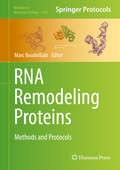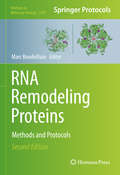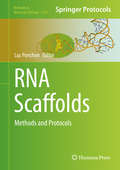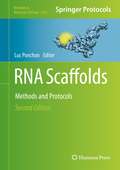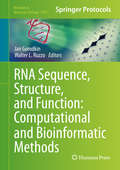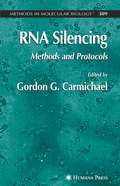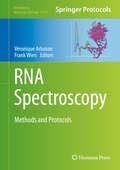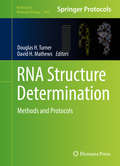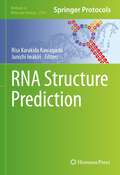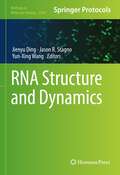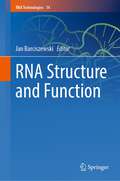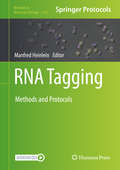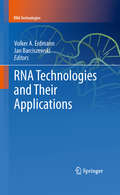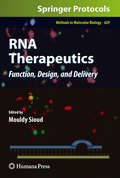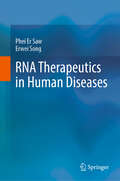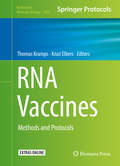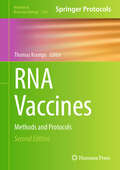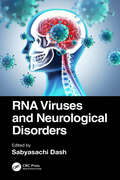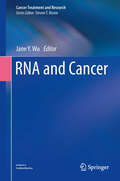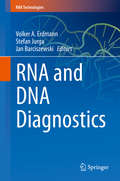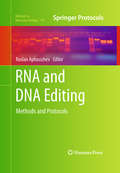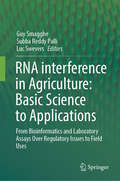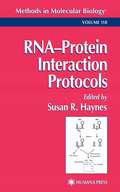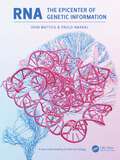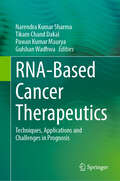- Table View
- List View
RNA Remodeling Proteins
by Marc BoudvillainThis volume provides readers with current methods to study RNA remodeling proteins. The methods, ranging from basic to complex, help the scientific community understand the role and fate of RNA species in cells, and their structures and interactions with other biomolecules. The book begins with two introductory chapters, followed by chapters where readers will find procedures to identify RNA remodeling proteins and their cofactors, physiological RNA targets and biological functions, and complex molecular mechanisms of action using purified components. Written in the highly successful Methods of Molecular Biology series format, chapters include introductions to their respective topics, lists of the necessary materials and reagents, step-by-step, readily reproducible laboratory protocols, and key tips on troubleshooting and avoiding known pitfalls. Authoritative and practical, RNA Remodeling Proteins: Methods and Protocols seeks to aid scientists in the further study of this ever evolving field of proteins and mechanisms.
RNA Remodeling Proteins: Methods and Protocols (Methods in Molecular Biology #2209)
by Marc BoudvillainThis volume provides the most current methods to study RNA remodeling proteins. Chapters detail methods, ranging from basic to complex, procedures to identify RNA remodeling proteins and their cofactors, physiological RNA targets and biological functions, and complex molecular mechanisms of action using purified components. Written in the highly successful Methods in Molecular Biology series format, chapters include introductions to their respective topics, application details for both the expert and non-expert reader, and tips on troubleshooting and avoiding known pitfalls. Authoritative and cutting-edge, RNA Remodeling Proteins: Methods and Protocols, Second Edition aims to ensure successful results in the further study of this vital field.
RNA Scaffolds
by Luc PonchonThis volume provides techniques on recent developments that use RNA scaffolds as molecular tools. RNA Scaffolds: Methods and Protocols guides readers through methods on various domains as molecular biology, nanotechnologies, and structural biology. Written for the Methods in Molecular Biology series, chapters include introductions to their respective topics, lists of the necessary materials and reagents, step-by-step, readily reproducible laboratory protocols and tips on troubleshooting and avoiding known pitfalls. Practical and authoritative, RNA Scaffolds: Methods and Protocols will serve as an invaluable reference for those interested in further study into this fascinating field.
RNA Scaffolds: Methods and Protocols (Methods in Molecular Biology #2323)
by Luc PonchonThis second edition volume expands on the previous edition with discussions of recently developed techniques that use RNA scaffolds as molecular tools. These latest methods are used in the fields of molecular biology, cellular biology, nanotechnology, and structural biology. The chapters in this book cover topics such as RNA footprinting using small chemical reagents; using tRNA scaffolds to assist RNA crystallization; identification of RNA-binding proteins associated to RNA structural elements; and synthetic biology medicine and bacteria-based cancer therapeutics. Written in the highly successful Methods in Molecular Biology series format, chapters include introductions to their respective topics, lists of the necessary materials and reagents, step-by-step, readily reproducible laboratory protocols, and tips on troubleshooting and avoiding known pitfalls. Cutting-edge and comprehensive, RNA Scaffolds: Methods and Protocols, Second Edition is a valuable resource that explores the fascinating uses of RNA in these different areas, and will inspire experts and novice researchers to further study this developing field.
RNA Sequence, Structure, and Function: Computational and Bioinformatic Methods
by Jan Gorodkin Walter L. RuzzoThe existence of genes for RNA molecules not coding for proteins (ncRNAs) has been recognized since the 1950's, but until recently, aside from the critically important ribosomal and transfer RNA genes, most focus has been on protein coding genes. However, a long series of striking discoveries, from RNA's ability to carry out catalytic function, to discovery of riboswitches, microRNAs and other ribo-regulators performing critical tasks in essentially all living organisms, has created a burgeoning interest in this primordial component of the biosphere. However, the structural characteristics and evolutionary constraints on RNA molecules are very different from those of proteins, necessitating development of a completely new suite of informatic tools to address these challenges. In RNA Sequence, Structure, Function: Computational and Bioinformatic Methods, expert researchers in the field describe a substantial and relevant fraction of these methodologies from both practical and computational/algorithmic perspectives. Focusing on both of these directions addresses both the biologist interested in knowing more about RNA bioinformatics as well as the bioinformaticist interested in more detailed aspects of the algorithms. Written in the highly successful Methods in Molecular Biology series format, the chapters include the kind of detailed description and implementation advice that is crucial for getting optimal results. Thorough and intuitive, RNA Sequence, Structure, Function: Computational and Bioinformatic Methods aids scientists in continuing to study key methods and principles of RNA bioinformatics.
RNA Silencing
by Gordon CarmichaelA collection of readily reproducible methods for the design, preparation, and use of RNAs for silencing gene expression in cells and organisms. The techniques range widely and include methods addressing the biochemical aspects of the silencing machinery, RNA silencing in non-mammalian organisms, and the in vivo delivery of siRNAs and silencing vectors. There are also techniques for designing, preparing, and using RNAs to silence gene expression, for fine-tuning regulation by targeting specific isoforms of a given gene, and for the study and use of microRNAs. The protocols follow the successful Methods in Molecular BiologyTM series format, each offering step-by-step laboratory instructions, an introduction outlining the principle behind the technique, lists of the necessary equipment and reagents, and tips on troubleshooting and avoiding known pitfalls.
RNA Spectroscopy: Methods and Protocols (Methods in Molecular Biology #2113)
by Véronique Arluison Frank WienThis volume looks at the different spectroscopic and biophysical methods used by researchers to study the structure and folding of RNA, and to follow their interactions with proteins. The chapters in this book cover topics such as single-molecule spectroscopy of multiple RNA species; surface plasmon resonance, MS or microcalorimetry for investigating molecular interactions with RNA; FTIR, SAXS, SANS and SRCD spectroscopies to analyze RNA structure; use of fluorescent nucleotides to map RNA-binding sites on proteins surfaces or CryoEM; and much more. Written in the highly successful Methods in Molecular Biology series format, chapters include introductions to their respective topics, lists of the necessary materials and reagents, step-by-step, readily reproducible laboratory protocols, and tips on troubleshooting and avoiding known pitfalls.Cutting-edge and comprehensive, RNA Spectroscopy: Methods and Protocols is a valuable resource for anyone interested in learning more about this developing field.
RNA Structure Determination
by Douglas H. Turner David H. MathewsThis volume provides protocols and procedures for determining and modeling RNA structure. Chapters guide the reader through protocols for RNA secondary structure prediction, single sequence modeling, Crumple, RNAstructure to model conserved secondary structures with multiple homologs, the prediction of bimolecular secondary structures with RNAstructure, STarMir, protocols for structure mapping, mapping data to constrain or restrain RNA secondary structure prediction with RNAstructure, unassigned NMR resonances, modeling protocols for Rosetta FARFAR, RNAComposer , ModeRNA, and MC-Fold. Written in the highly successful Methods in Molecular Biology series format, chapters include introductions to their respective topics, lists of the necessary materials and reagents, step-by-step, readily reproducible laboratory protocols, and tips on troubleshooting and avoiding known pitfalls. Authoritative and Practical, RNA Structure Determination: Methods and Protocols aims to ensure successful results in the further study of this vital field.
RNA Structure Prediction (Methods in Molecular Biology #2586)
by Risa Karakida Kawaguchi Junichi IwakiriThis book explores recent progress in RNA secondary, tertiary structure prediction, and its application from an expansive point of view. Because of advancements in experimental protocols and devices, the integration of new types of data as well as new analysis techniques is necessary, and this volume discusses additional topics that are closely related to RNA structure prediction, such as the detection of structure-disrupting mutations, high-throughput structure analysis, and 3D structure design. Written for the highly successful Methods in Molecular Biology series, chapters feature the kind of detailed implementation advice that leads to quality research results. Authoritative and practical, RNA Structure Prediction serves as a valuable guide for both experimental and computational RNA researchers.
RNA Structure and Dynamics (Methods in Molecular Biology #2568)
by Jienyu Ding Jason R. Stagno Yun-Xing WangThis volume provides a wide spectrum of multidisciplinary approaches for studying RNA structure and dynamics, including detailed accounts of experimental and computational procedures. Chapters guide readers through cryo-electron microscopy, crystallography, isothermal titration calorimetry, small angle X-ray scattering, single-molecule Förster Energy transfer, X-ray free electron laser, atomic force microscopy, computational simulation, and prediction. Written in the format of the highly successful Methods in Molecular Biology series, each chapter includes an introduction to the topic, lists necessary materials and reagents, includes tips on troubleshooting and known pitfalls, and step-by-step, readily reproducible protocols.Authoritative and cutting-edge, RNA Structure and Dynamics aims to be a foundation for future studies and to be a source of inspiration for new investigations in the field.
RNA Structure and Function (RNA Technologies #14)
by Jan BarciszewskiThis book focuses on the current status of our understanding of RNA, a key biological molecule. The various RNAs covered are messenger RNA, ribosomal RNA, transfer RNA, noncoding RNAs, modified nucleosides, and RNA enzymes. The different chapters detail methods to investigate RNA structure and function, the chemistry of modified RNAs, and the latest advances in our understanding of the vast array of biological processes in which RNA is involved.RNA, in one form or another, touches almost everything in a cell. RNA has both structural and catalytic properties. RNA fulfills a broad range of functions. These molecules are no longer seen as passive elements transferring the genetic information from DNA into proteins but regulate the activity of genes during development, cellular differentiation, and changing environments. RNAs are involved in various aspects of cell physiology and disease development. Discoveries of RNA with unexpected diverse functions in healthy and diseased cells, such as the role of RNA as both the source and countermeasure to cancer or severe viral infection, stimulate new trends, passion, and solutions for molecular medicine.In this book, fundamental questions about the biochemical and genetic importance of RNA, how mRNAs are generated and used to produce proteins, how noncoding and catalytic RNAs mediate key cellular processes, how to determine RNA structure and how to apply RNA in treatment of diseases.This book is an essential resource for researches in academia and industry contributing to the development of new RNA therapeutics. The book is geared toward scientists from the graduate level on up and particularly appeals to active investigators in RNA biology, molecular biology, and biochemistry.
RNA Tagging: Methods and Protocols (Methods in Molecular Biology #2166)
by Manfred HeinleinThis book provides a compendium of state-of-the-art methods for the labeling, detection, and purification of RNA and RNA-protein complexes and thereby constitutes an important toolbox for researchers interested in understanding the complex roles of RNA molecules in development, signaling, and disease. Beginning with a section on in situ detection of RNA molecules using FISH techniques, the volume continues with parts exploring in vivo imaging of RNA transport and localization, imaging and analysis of RNA uptake and transport between cells, identification and analysis of RNA-binding proteins, guide RNAs in genome editing, as well as other specific analytical techniques. Written for the highly successful Methods in Molecular Biology series, chapters include introductions to their respective topics, lists of the necessary materials and reagents, step-by-step, readily reproducible laboratory protocols, and tips on troubleshooting and avoiding known pitfalls. Authoritative and practical, RNA Tagging: Methods and Protocols serves as a vital reference for researchers looking to further the increasingly important research in RNA biology.
RNA Technologies and Their Applications
by Jan Barciszewski Volker A. ErdmannRNA technologies are the driving forces of modern medicine and biotechnology. They combine the fields of biochemistry, chemistry, molecular biology, cell biology, physics, nanotechnology and bioinformatics. The combination of these topics is set to revolutionize the medicine of tomorrow. After more than 15 years of extensive research in the field of RNA technologies, the first therapeutics are ready to reach the first patients. Thus we are witnessing the birth of a very exciting time in the development of molecular medicine, which will be based on the methods of RNA technologies. This volume is the first of a series. It covers various aspects of RNA interference and microRNAs, although antisense RNA applications, hammerhead ribozyme structure and function as well as non-coding RNAs are also discussed. The authors are internationally highly respected experts in the field of RNA technologies.
RNA Therapeutics
by Mouldy SioudCentral to the synthesis of proteins, the performance of catalysis, and many other physiological processes, the aberrant expression of which can be linked to human diseases including cancers, RNA has proven to be key target for therapeutics as well as a tool for therapy. In RNA Therapeutics: Function, Design, and Delivery, expert contributors from a broad spectrum of scientific backgrounds highlight the roles that messenger RNAs and small RNAs can play in biology and medicine. While covering the five major RNA-based drugs, namely the use of ribozymes to cleave and/or correct mRNA transcript, the use of siRNA for targeted silencing of gene transcripts, the use of aptamers, like short RNA molecules, for neutralizing the protein functions, the use mRNA-transfected DCs to activate immune system against tumor cells, as well as the use of RNA to reprogram T and/or DC cell function, this extensive volume brings together the fields of coding (mRNA) and non-coding RNA such as ribozymes, RNAse P, siRNAs, and miRNAs into one convenient source. Written in the highly successful Methods in Molecular BiologyTM series format, the cutting-edge protocol chapters contain introductions to their respective topics, lists of the necessary materials and reagents, step-by-step, readily reproducible laboratory protocols, and practical tips on troubleshooting and avoiding known pitfalls. Also, the book contains several excellent reviews for teaching purposes. Authoritative and comprehensive, RNA Therapeutics: Function, Design, and Delivery provides key models and tools which will assist researchers in increasing our understanding of RNA functions, modifications, and their involvement in diseases in order to lead to the design of vital new RNA-based therapeutics.
RNA Therapeutics in Human Diseases
by Erwei Song Phei Er Saw"RNA Therapeutics in Human Diseases" is a comprehensive guide to the rapidly evolving field of RNA-based therapies. Divided into three parts, the book covers RNA biology, technical advancements in RNA therapeutics, and their clinical applications. It explores the roles of various RNAs (including mRNA, miRNA, lncRNA, and circRNA) in disease mechanisms and therapeutic strategies, as well as cutting-edge techniques like RNA sequencing, RNA nanotechnology, and AI-driven drug design. Readers will gain in-depth insights into the latest RNA research and its potential to transform genetic medicine, providing both foundational knowledge and practical perspectives for researchers, clinicians, and policymakers.
RNA Vaccines
by Thomas Kramps Knut ElbersThis volume provides an overview of the field and practical hints for vaccinologists in academia and industry. Chapters provide protocols on self-replicating RNA vectors, non-replication mRNA vectors, adjuvantation and delivery, and preclinical and clinical development. Written in the highly successful Methods in Molecular Biology series format, chapters include introductions to their respective topics, lists of the necessary materials and reagents, step-by-step, readily reproducible laboratory protocols, and tips on troubleshooting and avoiding known pitfalls. Authoritative and cutting-edge, RNA Vaccines: Methods and Protocols aims to increased collaboration on RNA vaccines between basic and applied scientists in academia, government, and industry to develop future solutions for today's challenges.
RNA Vaccines: Methods and Protocols (Methods in Molecular Biology #2786)
by Thomas KrampsThis second edition volume expands on the previous edition with discussions of the latest technology and advancements in the development of RNA vaccines and proposed solutions on how to tackle currently unmet medical needs. The chapters in this book are organized into four parts and cover topics such as replication and non-replicating RNA vectors, formulation and delivery of RNA vaccines, and clinical and nonclinical development of RNA vaccines. Written in the highly successful Methods in Molecular Biology series format, chapters include introductions to their respective topics, lists of the necessary materials and reagents, step-by-step, readily reproducible laboratory protocols, and tips on troubleshooting and avoiding known pitfalls.Practical and comprehensive, RNA Vaccines: Methods and Protocols, Second Edition is a valuable resource for any researcher interested in learning more about this important and developing field.
RNA Viruses and Neurological Disorders
by Sabyasachi DashThis volume is an accessible introduction to RNA viruses and the infectious outcomes that they cause in the central nervous system (CNS). Chapters cover the major RNA viruses, their impact on the CNS, and the similarities and differences in pathological outcomes that can be observed. Neuroscientists, be they students, researchers, or clinicians, will benefit from the timely coverage provided. Our understanding of viruses, and specifically RNA viruses and their pathological impact, is rapidly evolving. For example, the close molecular interaction of viruses with the CNS cell types in the human host is poorly understood. Readers can use the book to understand clearly the cellular and molecular mechanisms governing pathological outcomes of RNA virus infection in the cell types of the human brain (e.g., neurons, endothelial cells, astrocytes, resident immune cells) based on summarized case studies, and gain insight into how cell type-specific defects affect brain function and cause poor clinical outcomes. The book is aimed primarily at neuroscience students and postgraduates wishing to learn about virology and professionals who are interested to learn more about virus-associated neuropathology. A basic knowledge of cell and molecular biology is assumed; however, readers across the disciplines of science, technology, engineering, and mathematics will find this topical and timely publication of value.
RNA and Cancer
by Jane Y. WuAccumulating evidence supports the role of defects in post-transcriptional gene regulation in the development of cancer. RNA and Cancer examines the recent advances in our understanding of post-transcriptional gene regulation, especially RNA processing and its role in cancer development and treatment. A particular focus is mRNA splicing, but other topics such as microRNAs, mRNA stability, the perinucleolar compartment, and oligonucleotide therapeutics are also covered in detail. All chapters have been written by internationally renowned experts. The book is intended for all with an interest in gene regulation and cancer biology, and especially for those not directly working on RNA biology, including clinicians and medical students. It is hoped that it will stimulate further innovative research collaborations between RNA biologists and cancer researchers to the benefit of patients.
RNA and DNA Diagnostics
by Jan Barciszewski Volker A. Erdmann Stefan JurgaThe aim of molecular diagnostics is preferentially to detect a developing disease before any symptoms appear. There has been a significant increase, fueled by technologies from the human genome project, in the availability of nucleic acid sequence information for all living organisms including bacteria and viruses. When combined with a different type of instrumentation applied, the resulting diagnostics is specific and sensitive. Nucleic acid-based medical diagnosis detects specific DNAs or RNAs from the infecting organism or virus and a specific gene or the expression of a gene associated with a disease. Nucleic acid approaches also stimulate a basic science by opening lines of inquiry that will lead to greater understanding of the molecules at the center of life. One can follow Richard Feynman's famous statement "What I cannot create, I do not understand. "
RNA and DNA Editing
by Ruslan AphasizhevThe recent expansion in diversity of RNA and DNA editing types has stimulated the development of many unique genetic, molecular, biochemical, and computational approaches to biological issues. In RNA and DNA Editing: Methods and Protocols, leading experts in the field introduce methods developed over the last few years to study editing substrates, mechanisms of specificity, and functions of RNA and DNA editing enzymes and complexes. Sections of the book are dedicated to state-of-the art techniques which enable investigation of uracil insertion/deletion RNA editing in mitochondrion of Trypanosoma brucei, adenosine to inosine RNA editing, cytidine to uracil RNA and DNA editing, as well as tRNA editing and RNA modifications. Written in the highly successful Methods in Molecular BiologyTM series format, chapters include introductions to their respective topics, lists of the necessary materials and reagents, step-by-step, readily reproducible laboratory protocols, and key tips on troubleshooting and avoiding known pitfalls. Authoritative and cutting-edge, RNA and DNA Editing: Methods and Protocols seeks to inspire the further development of these vital and powerful techniques.
RNA interference in Agriculture: From Bioinformatics and Laboratory Assays Over Regulatory Issues to Field Uses
by Guy Smagghe Subba Reddy Palli Luc SweversThe book covers the advanced concepts and creative ideas on the postgenomic tool of RNAi that received the Nobel Prize in 2006. Emphasis was placed on the mechanisms of RNAi, the core machinery and the applications in agriculture. This book covers contributions from academia, industry and Goverment regulatory authorities. Applications to control major important pest insects, as for example western corn rootworm with use of transgenic plant RNAi. But also attention was given to the use of RNAi as a spray (non-transgenic plant approach) or tree-injection. Examples include the control of Colorado potato beetle and treatment of citrus trees to control Asian citrus psyllid. Additionally, the aspect of biosafety and risk assessment were also covered in the book with input from the bioinformatics and risk assessment testing, combined with regulatory input from EPA-USA and EFSA-EU. In summary, the editors believe that this book provides for the first time an invaluable vast source of basic and applied information for a plethora of scientists in academia, industry, and regulatory, as well as a textbook for graduate and advanced undergraduate students.
RNA'Protein Interaction Protocols
by Susan R. HaynesHighly skilled experimentalists provide a comprehensive series of commonly used, as well as specialized, techniques for analyzing how proteins and RNA interact. Richly detailed and readily reproducible, these methods enable researchers to analyze the structural details of an RNA-protein interaction, to determine in detail what parts of the protein and RNA are in close contact, and to isolate RNP complexes from cells. There are also in vitro and in vivo methods and protocols for assaying the effects of proteins and RNP complexes on mRNA metabolism. The methods assume only a knowledge of basic molecular biology, biochemistry, and cell culture, and can be readily adapted to other systems. RNA-Protein Interaction Protocols offers a wide-ranging collection of up-to-date experimental methods that will assure productive and reproducible results for all investigators in the field.
RNA, the Epicenter of Genetic Information
by John Mattick Paulo AmaralThe origin story and emergence of molecular biology is muddled. The early triumphs in bacterial genetics and the complexity of animal and plant genomes complicate an intricate history. This book documents the many advances, as well as the prejudices and founder fallacies. It highlights the premature relegation of RNA to simply an intermediate between gene and protein, the underestimation of the amount of information required to program the development of multicellular organisms, and the dawning realization that RNA is the cornerstone of cell biology, development, brain function and probably evolution itself. Key personalities, their hubris as well as prescient predictions are richly illustrated with quotes, archival material, photographs, diagrams and references to bring the people, ideas and discoveries to life, from the conceptual cradles of molecular biology to the current revolution in the understanding of genetic information. Key Features Documents the confused early history of DNA, RNA and proteins - a transformative history of molecular biology like no other. Integrates the influences of biochemistry and genetics on the landscape of molecular biology. Chronicles the important discoveries, preconceptions and misconceptions that retarded or misdirected progress. Highlights major pioneers and contributors to molecular biology, with a focus on RNA and noncoding DNA. Summarizes the mounting evidence for the central roles of non-protein-coding RNA in cell and developmental biology. Provides a thought-provoking retrospective and forward-looking perspective for advanced students and professional researchers.
RNA-Based Cancer Therapeutics: Techniques, Applications and Challenges in Prognosis
by Pawan Kumar Maurya Gulshan Wadhwa Narendra Kumar Sharma Tikam Chand DakalBy consistently dedicating efforts to multi-omic and other high-throughput technologies, it is expected that RNA therapies will have a vital role in future personalized medicine approaches for cancer therapy. Within this framework, analyzing the genetic sequence of a patient's tumor would allow for the detection of crucial driver mutations or changes that cause resistance to drugs. These mutations may then be targeted with RNA therapies that are particularly designed to treat those particular variations. Recent clinical trials have shown that RNA-based therapies hold great potential for treating several illnesses. However, further investigations are required to improve the delivery materials and understand the RNA alterations linked to these groundbreaking drugs, in order to facilitate their integration into clinical practice. Ideally, these therapeutic substances would be specifically administered to the tumor cells of interest using a targeted delivery agent. In this hypothetical situation, the choice of medications for cancer patients would differ depending on the precise abnormalities detected in each person, potentially including inhibitors that target circuits known to cause resistance to treatments. However, doing a more thorough assessment of the challenges and potential benefits discussed in each chapter would enhance the capacity to critically analyze this rapidly evolving field of therapies. This book largely examines the latest developments and clinical studies related to RNA-based medications, while also examining the challenges and future possibilities linked with them. This method shows potential for greatly improving the prognosis of cancer patients.
